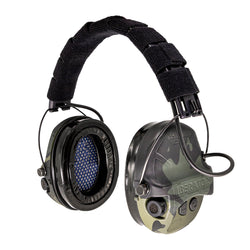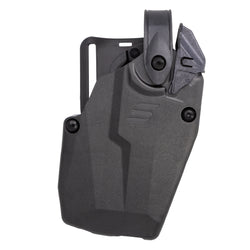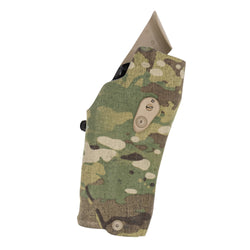One of the best practices, and most underrated tools in the training toolbox, is dry fire. It’s somewhat boring and certainly isn’t sexy, but think of dry fire as the light to the path of becoming a better shooter. It’s basically free, and all it takes is a little time and dedication.
How much time? If you were to practice for a mere 15 minutes a day, you’d see some radical improvement in your shooting skills. Today, we will delve into dry fire, offering some general advice on how to maximize its benefits and stay safe.
Dry Fire Safety
Guns and safety should be like peanut butter and jelly; they stick together. Safe handling procedures are paramount. When dry firing, we are going to clear the firearm by removing the magazine and visually and physically checking the chamber.

The general rule of thumb should be that ammunition isn’t even stored in the same room as you are when dry firing. And, of course, we still follow the rules of firearm safety. We aren’t going to point our guns at things we aren’t willing to destroy.
I’m not even going to point my gun at a wall that a family member could be sitting on the other side of. It’s pointed in a safe direction, and I’m practicing every safety rule possible. Be cautious, be safe, and anytime you’re unsure, clear the weapon again.
General Advice About Dry Fire
I have a few basic tips I want to share about dry fire to help make sure your dry fire is productive.
Practice What You Know
Dry fire is practice, not training. Training is where you learn, and practice is where you reinforce your training. You don’t want to start dry-firing something you haven’t been trained in.

If you’re trying to practice a draw from concealment but you’re not sure exactly how to do that, then maybe you shouldn’t dry fire that technique. You risk building bad habits, which will take time to smooth out.
Practice what you know when you dry fire.
Making It Routine
I get that it can be boring to dry fire, but you have to make it a routine. It’s like working out; if you do it once a month or sporadically, then you won’t see progress. Make it a routine.
Practice daily, or every other day at least. Make it routine. Trust me, performance slips suck and you’ll have to rebuild your skills after a lapse in training or practice.
Do It Right, Even When It’s Slow
Going fast is a lot of fun. It looks cool, feels cool, and we all want to see our shot timer time get lower and lower.

Dry fire is the time to build good foundational skills. Foundations are not constructed fast. Start slow, treat it like a warm-up. Go as fast as you can while doing it absolutely perfectly.
There Are Whole Books On This
Ben Stoeger has an entire series of books written about Dry Fire. They are excellent reads and help inspire me to dry fire more. Stoeger is a champion shooter, a Grand Master, and a good writer.

Read the books, follow their advice, and build your routine. Speaking of routines, I promised you one.
A Basic Daily Dry Fire Routine
If you have 15 minutes to doomscroll Twitter, watch AI-created Instagram Reels, and the like, then you have time to dry fire. Hell, when you watch your favorite Guntuber, use that time to dry fire. Here’s a basic 15-minute routine you can follow at home.
Basic Trigger Presses: Three Minutes
The first three minutes will focus on getting a solid grip on your gun and practicing with a perfect grip and perfect stance. Use a small target, be it a light switch, a piece of tape, or something similar.

Practice getting perfect shots fired with a perfect stance and grip. Focus on building those foundational functions and press the trigger as necessary. It’s not fun or exciting, but it’s a core part of basic dry fire.
One-Handed Trigger Presses: Six Minutes
We are going to switch it up a bit. I would occasionally practice with a single hand, but I was never serious about it. Then, I injured my shoulder at Judo. Ever since then, I’ve been a big advocate for practicing with a single hand.
We still want the best grip we can and the best stance we can. Practice building that stance and find one that works for you. I keep my thumb up and the gun as straight as possible, and I also secure my off-hand to prevent it from swinging.

Practice with both hands; give them three minutes each.
Malfunction Clearance: Three Minutes
You might need a snap cap for more advanced malfunction drills, but for a basic tap-rack-bang drill, it’s not that difficult. A tap-rack-bang drill is extremely easy to practice, and it is a more valuable skill for most concealed carriers than a reload.

When you’re dry-firing your gun, it always goes click, but we are going to simulate a click instead of a bang. When that occurs, you’ll tap the bottom of the grip and magazine with your support hand, rack the slide, and then reengage.
Do it perfectly, and then add speed. Don’t add speed for speed’s sake. Ensure you give the gun and magazine a good tap and move the slide fully to the rear. Work this for three minutes.
Draw and Dry Fire: Three Minutes
Finally, let’s work our draw, assuming you know how. This can be our grand finale. We will start with the gun holstered, facing our target. As always, we will proceed at a pace that allows us to do it perfectly.

Establish a good grip, draw the gun from your holster, and present perfectly, getting the gun on target and pulling the trigger. If you can go fast, go fast! If not, there is no shame in being slow and methodical.
Remember, there is more to the draw than the actual draw. Focus on your grip, stance, and your draw.
Alternatively — Reverse Presentation: Three Minutes
If you haven’t gotten training in how to draw, then let’s do something a little different for your last three minutes. Start at full presentation with your sights on target. From here, you’ll break down your presentation and draw in reverse.

You’ll go from the full draw to the position where your hands meet from the draw, then fully reverse the draw and reholster the firearm. Repeat, breaking down the draw over and over with a single shot at the beginning of each reverse presentation.
This will help you build your presentation and can be highly beneficial for shooters new to red dots.
Going Dry
Dry fire is not a ton of fun. I get that it can be boring, but it’s also so darn useful.
Everyone who is serious about firearms should dry fire. Even just a few times a week for 15 minutes at a time. If you can do that, you’ll see your skills grow significantly.









